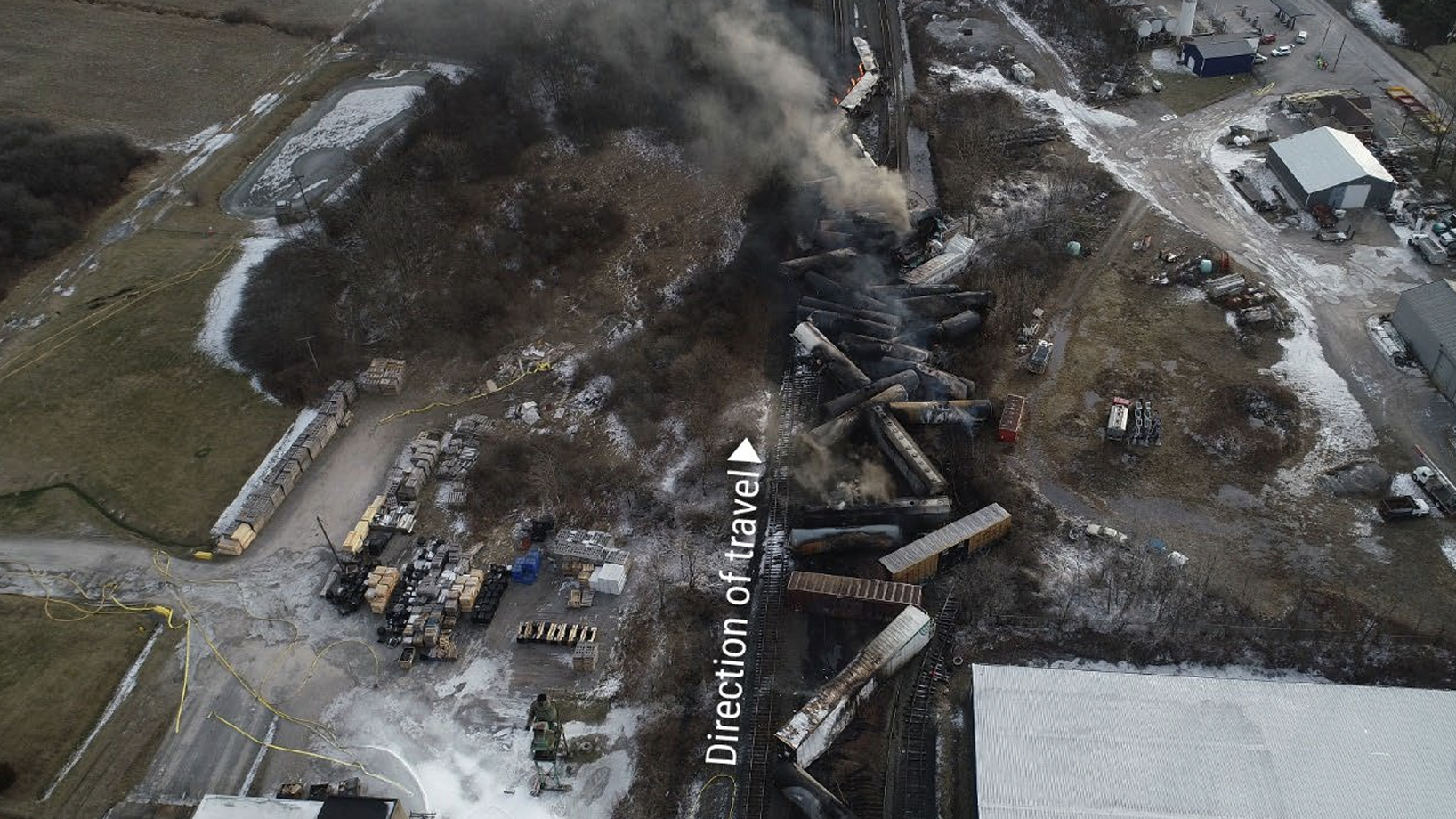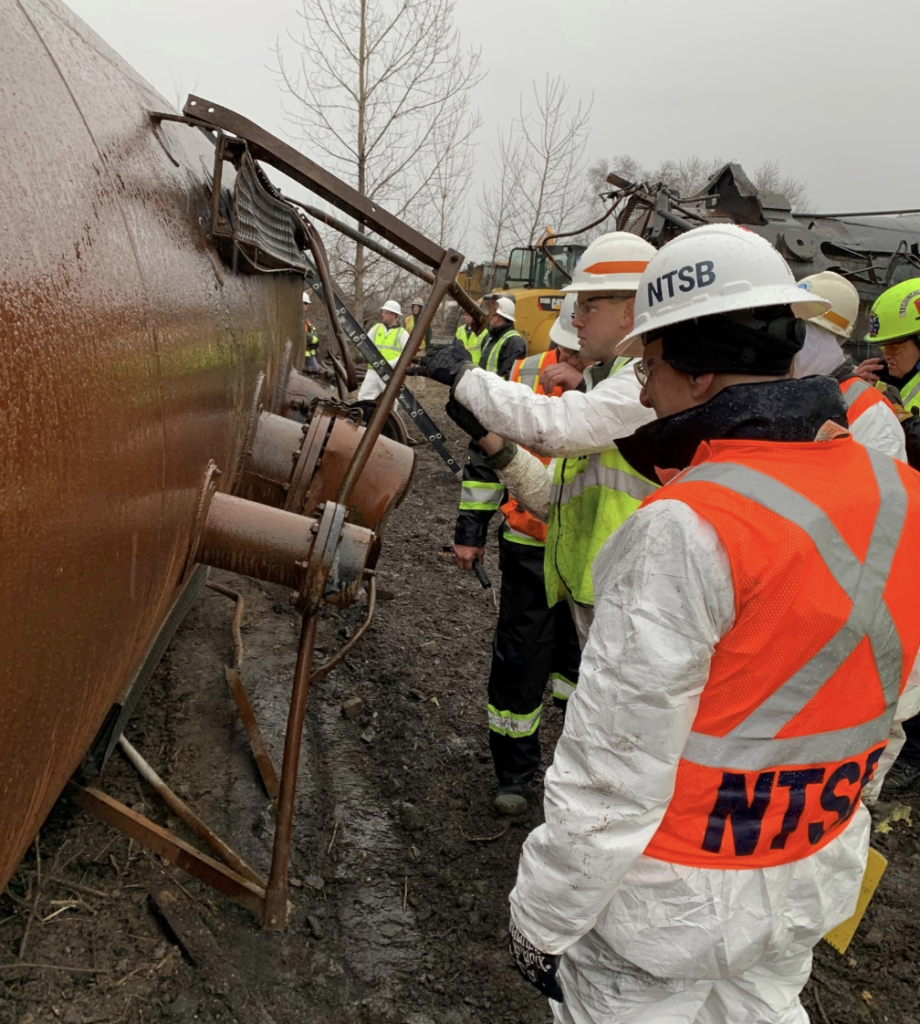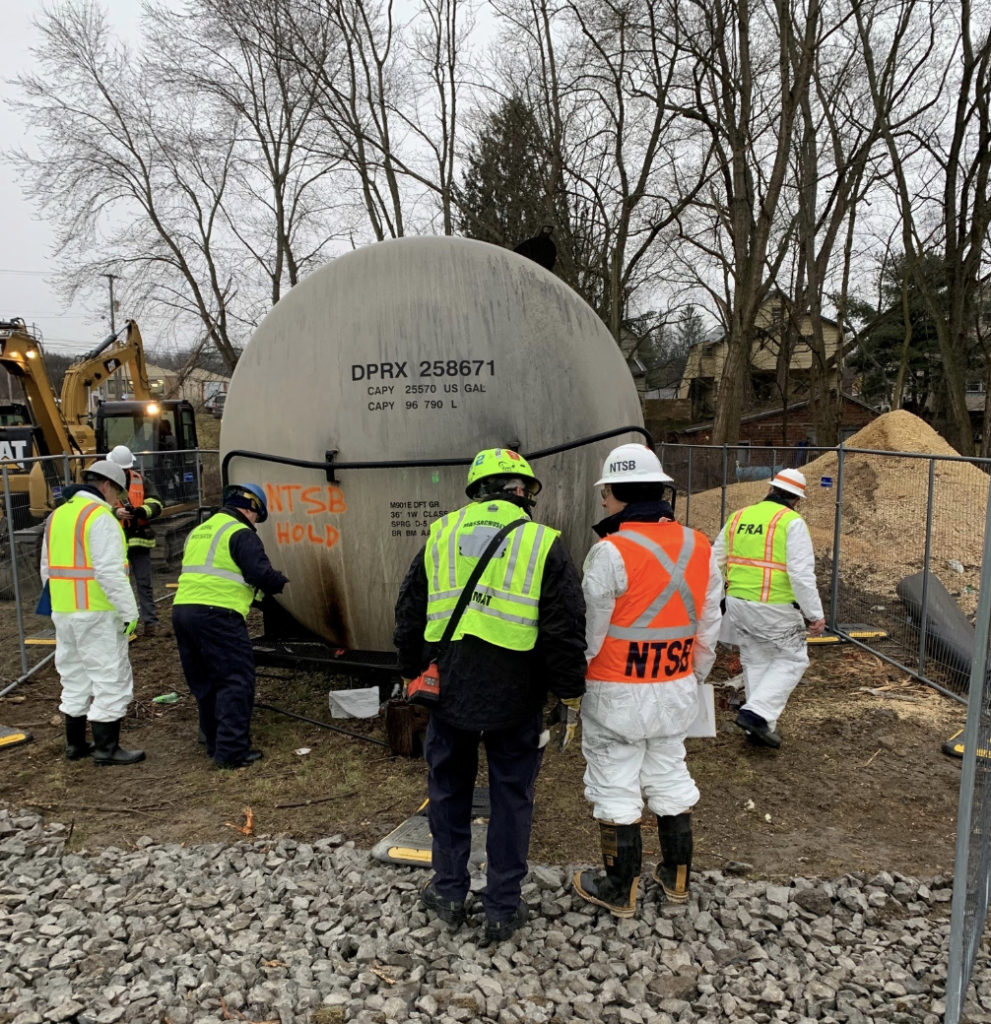
NTSB Issues Preliminary Report on NS Ohio Derailment
Written by Marybeth Luczak, Executive Editor
Aerial photograph of derailment site, courtesy of the NTSB.
The National Transportation Safety Board on Feb. 23 released a preliminary report on its investigation into the Norfolk Southern (NS) derailment in East Palestine, Ohio. NS, the Association of American Railroads (AAR) and the Railway Supply Institute (RSI) respond.
The investigation of the Feb. 3 derailment of eastbound NS general merchandise train 32N, which was hauling vinyl chloride and a variety of other freight, is ongoing. The Feb. 23 report (download below) provided initial findings or factual information only. The timing between the beginning of an investigation and a probable-cause determination and report “varies based on the complexity of the investigation and the workload of the agency’s investigators,” according to the NTSB. NTSB Chair Jennifer L. Homendy has said the investigation will take 12-18 months.
According to the NTSB, 38 railcars of train 32N derailed on main track 1 of the NS Fort Wayne Line of the Keystone Division in East Palestine. Eleven were “carrying hazardous materials that subsequently ignited, fueling fires that damaged an additional 12 non-derailed railcars,” the agency reported. “First responders implemented a 1-mile evacuation zone surrounding the derailment site that affected up to 2,000 residents. There were no reported fatalities or injuries. At the time of the accident, visibility conditions were dark and clear; the weather was 10°F with no precipitation.”
The 149-car train included two head-end locomotives and one distributed power locomotive located between railcars 109 and 110. According to the NTSB, the consist included 20 placarded hazardous materials (hazmat) tank cars transporting combustible liquids, flammable liquids, and flammable gas, including vinyl chloride. The train was traveling about 47 mph at the time of the derailment, “which was less than the maximum authorized timetable speed of 50 mph,” reported NTSB, which noted that train movements near the derailment site “are authorized by cab signals and wayside signal indications with an overlaid positive train control [PTC] system and are coordinated by the NS Cleveland East train dispatcher located in Atlanta, Ga.” The PTC system was enabled and operating at the time of the derailment, NTSB reported.
“Train 32N was operating with a dynamic brake application as the train passed a wayside defect detector on the east side of Palestine, Ohio, at milepost (MP) 49.81.4,” NTSB reported. “The wayside defect detector, or hot bearing detector (HBD), transmitted a critical audible alarm message instructing the crew to slow and stop the train to inspect a hot axle. The [locomotive] engineer increased the dynamic brake application to further slow and stop the train. During this deceleration, an automatic emergency brake application initiated, and train 32N came to a stop.
“On the Fort Wayne Line of the Keystone Division, NS has equipped its rail network with HBD systems to assess the temperature conditions of wheel bearings while en route. The function of the HBD is to detect overheated bearings and provide audible real-time warnings to train crews. Train 32N passed three HBD systems on its trip before the derailment. At MP 79.9, the suspect bearing from the 23rd car had a recorded temperature of 38°F above ambient temperature. When train 32N passed the next HBD, at MP 69.01, the bearing’s recorded temperature was 103°F above ambient. The third HBD, at MP 49.81, recorded the suspect bearing’s temperature at 253°F above ambient. NS has established the following HBD alarm thresholds (above ambient temperature) and criteria for bearings:
- “Between 170°F and 200°F, warm bearing (non-critical); stop and inspect
- “A difference between bearings on the same axle greater than or equal to 115°F (non-critical); stop and inspect
- “Greater than 200°F (critical); set out railcar

“After the train stopped, the crew observed fire and smoke and notified the Cleveland East dispatcher of a possible derailment. With dispatcher authorization, the crew applied handbrakes to the two railcars at the head of the train, uncoupled the head-end locomotives, and moved the locomotives about 1 mile from the uncoupled railcars. Responders arrived at the derailment site and began response efforts.”
The NTSB said that while on scene, its investigators examined railroad equipment and track conditions; reviewed data from the signal system, wayside defect detectors, local surveillance cameras, and the lead locomotive’s event recorder and forward-facing and inward-facing image recorders; and completed interviews. They identified and examined the first railcar to derail, the 23rd in the consist.
“Surveillance video from a local residence showed what appeared to be a wheel bearing in the final stage of overheat failure moments before the derailment,” NTSB reported. “The wheel bearing and affected wheelset have been collected as evidence and will be examined by the NTSB. The vinyl chloride tank car top fittings, including the relief valves, were also removed and examined by the NTSB on scene. The top fittings will be shipped to Texas for testing under the direction of the NTSB.”

According to the NTSB, the hazmat tank cars have been decontaminated. NTSB investigators returned to Ohio on Feb. 21 to examine each hazmat tank car, document damage and secure evidence for laboratory analysis.
The NTSB said that its “future investigative activity will focus on the wheelset and bearing; tank car design and derailment damage; a review of the accident response, including the venting and burning of the vinyl chloride; railcar design and maintenance procedures and practices; NS use of wayside defect detectors; and NS railcar inspection practices.”
The parties to the investigation include the Pipeline and Hazardous Materials Safety Administration; Federal Railroad Administration; Ohio State Highway Patrol, village of East Palestine, Ohio; NS; Trinity Industries Leasing Company; GATX Corporation; Brotherhood of Railway Carmen; International Association of Sheet Metal, Air, Rail and Transportation Workers; Brotherhood of Locomotive Engineers and Trainmen; and International Association of Fire Fighters.
The NTSB noted that it “is not involved in air monitoring, testing of water quality, environmental remediation, or evacuation orders. Questions on environmental issues should be referred to the Environmental Protection Agency.”
Industry Response
NS issued the following statement on the preliminary report:
“Since the incident, Norfolk Southern has focused on supporting the Village of East Palestine and the NTSB throughout their investigation. NTSB investigators have worked tirelessly, and we appreciate everything they are doing. We share the NTSB Chair’s frustration about the significant misinformation about the incident.
“Norfolk Southern will continue to support the NTSB’s investigation. Their preliminary report indicates:
- “The rail crew operated the train within the company’s rules.
- “The rail crew operated the train below the track speed limit.
- “The wayside heat detectors were operating as designed.
- “Once the rail crew was alerted by the wayside detector, they immediately began to stop the train.
“The company’s wayside detectors on its network trigger an alarm at a temperature threshold that is among the lowest in the rail industry.
“At Norfolk Southern, our highest priority is the safety of our people and the communities and customers we serve. Under the supervision of the Federal Railroad Administration, the company has inspected all wayside detectors in the area of the incident and found they were operating as designed. Out of an abundance of caution, Norfolk Southern is now inspecting all of the nearly 1,000 wayside heat detectors on its system—on top of the regular inspection of the detectors every 30 days.
“We and the rail industry need to learn as much as we can from this event. Norfolk Southern will develop practices and invest in technologies that could help prevent an incident like this in the future. We will also work with the owners of the railcars on the integrity and safety of the equipment we use.
“The speculation and misinformation about this incident have been extremely upsetting to the citizens of East Palestine. Norfolk Southern remains committed to the people of the community and will continue its work to help them thrive. Already, we have made significant progress in cleaning the site, engaging the community, and providing financial support for families and small businesses, all to help East Palestine.
AAR President and CEO Ian Jefferies released this statement in response to the report:
“NTSB’s deliberate and methodical approach under these challenging circumstances has been essential to establishing independent, credible findings into the cause of the accident in East Palestine. As an industry, railroads will use this initial report in shaping a thoughtful, fact-driven approach to prevent another similar accident before it can occur elsewhere. As stakeholders review this preliminary report, the railroads will continue to follow this ongoing investigation closely and look forward to reviewing NTSB’s final report. We share a singular mission of taking meaningful steps to further improve safety.”
The RSI, whose members manufacture, own and maintain the vast majority of railcars and locomotives and provide technology solutions for transporting freight across the U.S. railway system, said:
“While 99.9% of all hazmat shipments by rail reach their destination without incident, that statistic is small consolation to the residents of East Palestine, who have our sympathy during this difficult time. The safety of the community of East Palestine is paramount. The NTSB is actively fulfilling its role of conducting an independent accident investigation and, where appropriate, will advocate for safety enhancements. The RSI and its members prioritize safety above all else, but also believe that hastily recommended policy solutions are premature until the NTSB has completed its investigation of the causal and root factors in this incident. RSI looks forward to lending its technical expertise on railcar design and integrity to members of the NTSB, and stands ready to be part of discussions around proposed solutions when the report is completed.”
Further Reading:
USDOT Issues Safety “Calls for Action”
NS Ohio Derailment Under Investigation; NTSB Preliminary Report Scheduled



